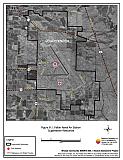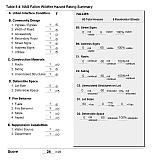8.0 Fallon Naval Air Station
8.1 Risk and Hazard Assessment
The Fallon Naval Air Station is located approximately seven miles southeast of the City of Fallon, accessible by U.S. Highways 50 and 95. The hazard assessment resulted in classifying the Fallon NAS in the Low Hazard category (24 points). A summary of the factors that contributed to the hazard rating is included in Table 8-4. The primary factors that contributed to the low rating were the buffer zones around the base, sparse vegetation, as well as good community design and adequate defensible space.
8.1.1 Community Design
The Fallon NAS is a classic interface community. There is a clear line of demarcation between the structures and the wildland area. All of the residences are on lots of less than one acre in size. Sixty homes on the NAS were included in the assessment.
- Roads: State Route 118, a paved two-lane highway, is the major transportation route into the base. All secondary roads are paved and provide adequate room for fire suppression equipment to maneuver.
- Signage: Street signs and residential addresses were clearly posted and visible on all roads and homes on the NAS. Clear and visible residential addresses are important to aid fire protection personnel in locating homes during low visibility conditions that may occur during a wildland fire.
- Utilities: Electric utilities were all above ground. In general, power line right-of-ways were adequately maintained and posed only a low ignition risk to the community.
8.1.2 Construction Materials
All of the homes in the interface were built with non-combustible siding and roofing materials. None of the homes on the NAS had unenclosed balconies, porches, decks, or other architectural features that create drafts and provide areas where sparks and embers can smolder and rapidly spread fire if the home ignites.
8.1.3 Defensible Space
All of the homes met the minimum defensible space requirements to protect the home from damage or loss during a wildfire.
8.1.4 Suppression Capabilities
Wildfire Protection Resources
The Fallon NAS is protected by a career fire department staffed by 45 members in two stations. Additional resources are available from the Fallon/Churchill VFD and the BLM, dispatched from the Sierra Front Interagency Dispatch in Minden, Nevada. Tables 8-1 and 8-2 list the types of wildfire resources, cooperating partners, and equipment available to the NAS for response to respond to a reported wildland fire.
| Type of Equipment | Amount of Equipment | Cooperating Partner (Resource Location) |
|---|---|---|
| Type 1 Engine Type 3 Engine (1) Type 6 Engine Type 1 Water Tender |
1 1 1 1 |
Fallon Naval Air Station |
| Type 1 Engine Type 3 Engine Type 1 Water Tender (4,000 gal.) Command Officer |
6 2 3 1 |
Fallon/Churchill VFD |
| (1) The Type 3 engine listed under the Fallon Naval Air Station was in a state of disrepair at the time of the assessment. | ||
| Type of Equipment | Amount of Equipment | Cooperating Partner (Resource Location) |
|---|---|---|
| Type 3 Engine Water Tender Incident Command Type 1 Air Tanker Air Attack |
1 1 1 1 1 |
The closest available Bureau of Land Management resources dispatched by the Sierra Interagency Dispatch Center in Minden, Nevada |
| Source: Personal Communication with Leonard Waking Fire Management Officer BLM Carson City Field Office, Steven Edgar Fire Mitigation and Education Specialist BLM Carson City Field Office, Ed Harris Equipment Manager Fallon/Churchill VFD, and Stuart Cook Fire Management Officer Fallon Naval Air Station. | ||
Water Sources and Infrastructure
Water availability for fire suppression on the Fallon NAS include:
- Community wells.
- 500 gpm hydrants within 500 feet of structures.
- 2 water storage tanks.
The water system relies on gravity and electric pumps, and is backed up by a diesel emergency generator in the event of a power outage.
Detection and Communication
Fires are reported on the Fallon NAS area through 911 calls to Fallon NAS Fire Dispatch. The Base utilizes tower lookouts, reconnaissance flights, and Base Security patrols.
Fires are communicated to fire response personnel through:
- Dispatch through Base Security.
- Radios using Base frequency.
- Pagers.
The Fallon NAS relies primarily on its Base frequency, but as of April 2004 it also has access to the state mutual aid frequencies and compatibility with neighboring agencies. There is a community siren to notify residents of an emergency. There are gaps in radio coverage in Dixie Valley, where the Fallon NAS performs practice drills.
Fire Protection Personnel Qualifications
The Fallon NAS Fire Department personnel are trained under the Department of Defense Training Guidelines set by National Fire Protection Agency (NFPA). All staff members have completed the forty-hour BLM Advanced Wildland Fire Training course. The Fallon NAS Fire department does not utilize the Red Card System for individual qualifications. A Red Card certification is part of a fire qualifications management system used by many state and all federal wildland fire management agencies to certify that an individual is qualified to fight wildland fires.
Work Load
On average, the Fallon NAS Fire Department responds to the following number of emergency calls annually:
- 800-1,000 emergency medical calls.
- 5-10 wildland/brush fires.
- 3,000 airfield/structure fires.
Financial Support
Financial support for the Fallon NAS Fire Department comes from the Federal Government, Department of the Navy. Federal budget cuts have reduced funding available to the Fire Department for equipment and repairs.
Community Preparedness
The Fallon NAS has an active Local Emergency Management Plan that includes a pre-attack plan, disaster plan, mitigation plan, and an evacuation plan. The Base Emergency Management Coordinator is responsible for management of the plan. The plan is periodically updated. The Fallon NAS currently operates under NFPA standards and Naval Regional Regulations for fire code. The Fallon NAS Fire Department reviews development plans to ensure that new development meets current fire code standards. The Fallon NAS Fire department has a brush clearance program that follows Navy Requirements of 25-foot minimum defensible space areas around structures. The requirements apply to structures on the Base and in Dixie Valley.
8.1.5 Factors That Affect Fire Behavior
The vegetative fuel density on the Fallon NAS interface area was light. Fuels on the base itself consisted primarily of a salt desert shrub community of greasewood and saltgrass. Fuels in the buffer zone surrounding the base were the same but of a heavier density. The fuel load was estimated to be one to two tons per acre and considered a low fuel hazard. There has been no recent wildfire activity recorded in the area. The Fallon NAS is located in a valley with a fairly flat aspect and minimal slope. The predominant wind comes from the southwest in the late afternoon.
8.1.6 Worst Case Wildfire Scenario
The worst-case scenario for the Fallon NAS would be an ignition starting south of the base and then spreading onto the Base with the prevailing southwest wind. Possible ignition sources include lightning, ditch burning, or a plane crash. Because of the low, sparse brush, the wildfire threat is low, as is the potential for structure loss.
8.1.7 Risk Assessment
The Fallon NAS is viewed as having a low ignition risk area due to sparse, low brush in and around the community, non-combustible structure materials, good defensible space, adequate road access, and appropriate road/address signage. The dominant ignition risk factor on the Fallon NAS would be an aviation accident.
8.2 Risk and Hazard Reduction Recommendations, Roles, and Responsibilities
The Fallon NAS risk and hazard reduction recommendations focus on defensible space in some areas of the Base with regard to structures on land leased from the Navy and upgrading/repair of the existing fire suppression equipment. The recommendations are detailed below and summarized in Table 8-3.
8.2.1 Property Owner Responsibilities
Defensible Space Treatments
Density and type of fuel around a home determines the potential fire exposure levels to the home. The goal of defensible space is to reduce the chances of a wildfire spreading into adjacent property, igniting homes, and reducing the risk of loss from a wildfire. All of the homes on the Fallon NAS are maintained by the Base and do not have issues with defensible space or debris. General guidelines for creating defensible space around residences and structures on lands leased from the Navy by private persons are given below, and illustrated in the Defensible Space Guidelines in Appendix D. See also the Homeowner’s Annual Checklist in Appendix D for additional information.
- Leaseholders on Navy lands should ensure that appropriate defensible space is maintained around structures by removing, reducing, and replacing vegetation around homes according to the guidelines in Appendix D. This area should be kept:
- Lean: There are only small amounts of flammable vegetation.
- Clean: There is no accumulation of dead vegetation or other flammable debris.
- Green: Existing plants are healthy and green during the fire season.
- Maintain defensible space annually.
- Immediately dispose of cleared vegetation when implementing defensible space treatments. This material dries quickly and poses a fire hazard if left on site. While the Navy guidelines require 25 feet of defensible space, the UNR Defensible Space figure in Appendix D recommends a minimum of thirty feet clearance.
8.2.2 Fallon NAS Fire Department Responsibilities
Fire Suppression Resources
- The Fallon Naval Air Station Fire Department should explore opportunities to gain funding to repair the Type 3 brush engine and/or find funding to replace the engine. Type 3 engines are the primary vehicle used in suppression of wildland fires, and repair or replacement would enhance the ability of the Fallon NAS Fire Department to respond to wildland-urban interface fires both on and off the base.
Community Coordination
- The Fallon NAS Fire Department should work with the Fallon/Churchill VFD to implement a call-in or burn permit program that includes NAS leaseholders.
Public Education
- Distribute copies of the publication “Living With Fire” to all Base residents and leaseholders. This publication is free of charge. Copies can be requested from the University of Nevada Cooperative Extension, (775) 784-4848.
8.3 Summary of Recommendations
| Responsible Party |
Recommended Treatment | Recommendation description |
|---|---|---|
| Property Owners | Defensible Space Treatments | Remove, reduce, and replace vegetation around homes according to the guidelines in Appendix D. Maintain defensible space as needed to keep the space lean, clean, and green. |
| Fallon NAS FD | Fire Suppression Resources | Explore funding opportunities to repair Type 3 engine and/or replace with another Type 3 engine. |
| Community Coordination | The Fallon NAS Fire Department should work with the Fallon/Churchill VFD to implement a call-in or burn permit program that includes NAS leaseholders. | |
| Public Education | Distribute copies of the publication “Living With Fire” to all residents and leaseholders. |
Figure 8-1Fallon Naval Air Station Suppression Resources |
 |
Table 8-4Fallon Naval Air Station Wildfire Hazard Assessment Rating Summary |
 |
